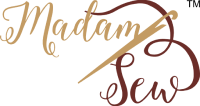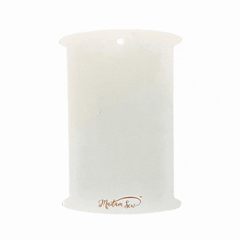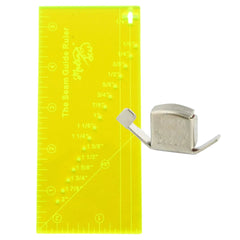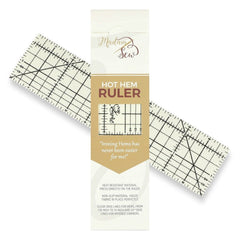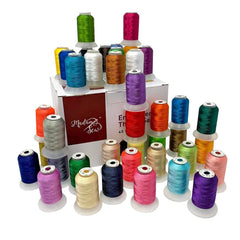How to Store Sewing Patterns
If you’ve ever found yourself flipping through piles of folded tissue paper, digging through a disorganized binder, or wondering where that traced sleeve piece disappeared to, this guide is for you. Many of us probably have pattern stashes that could pretty much fill the shelves of a small library. So, I thought it would be fun to explore some storage options. And when it comes to storage, we also have to consider the need to store different types of patterns. It's a challenge, but I’m here to help you through it with my top tips for storing your pattern stash. Storing sewing patterns isn’t just about tidying up your space—it’s about making your creative process smoother and more enjoyable.
The key? Look at the different types of patterns you own, sort them out, categorize and choose the right storage solution for each type.
Types of Sewing Patterns
Each type of pattern has a different need when it comes to organization and storage. Here are the five most common sewing pattern types:
1. Printed PDF Patterns
PDF patterns are usually downloaded from online pattern shops, designers or marketplaces, and then printed at home (tiled on regular letter or A4 paper) or printed in large format at a print shop.
2. Commercially Bought Patterns
Store-bought patterns from brands like Simplicity, McCall’s, Butterick. These are usually printed on delicate tissue paper and packaged in an envelope. They are very compact when you buy them and haven’t used them but once unfolded or used, they can be hard to fold and fit back in that small envelope.
3. Pattern Magazines
Sewing Pattern Magazines like BurdaStyle, Ottobre or Fiber Mood have several overlapping patterns printed on a couple of very large sheets, printed recto and verso. When you want to use a pattern, these patterns mostly require tracing on pattern paper before use. If you start cutting the original pattern, you might damage a pattern piece that you need.
4. Hand Drawn Paper Patterns
Patterns traced from sewing pattern books, clothes, or magazine sheets, usually made of tracing paper, parchment/baking paper, or similar materials.
5. Cardboard Patterns
Durable, often reused patterns made of cardboard. These are basic patterns, basic forms to design new patterns or custom made patterns for personal designs or garments that you make frequently.
Four Different Storage Solutions That Work
Patterns and large cut out pattern pieces in different shapes can be hard to fold neatly and identify and label for later use. The folded pieces often make it difficult to copy the pieces on your fabric. The tissue paper is very fragile.
Depending on the amount of patterns you own, the type and size of your patterns, and your available storage space different storage methods may suit you better. Below are some storage ideas that I think work for one or more of the above mentioned pattern types.
1. Plastic Folders or Envelope Storage
Ideal for: PDF Patterns, Traced Patterns, Commercial Patterns
Use large paper envelopes or clear plastic sleeves like the binder pockets from Madam Sew to store individual patterns. I like the fact that the plastic folders are transparent and can stand up neatly. The envelopes you can find easily on Etsy.
With both envelopes and plastic folder, you can:
• Slip in printed instructions and folded pattern pieces
• Label each folder and add the pattern name and type (like children’s clothing, bags, or men’s wear)
• Store and organize them in bins, baskets or boxes, or upright in magazine holders.
💡Madam Sew’s binder pockets can also be stored in a three ring binder or even the Madam Sew carry-all sewing organizer. This is a multi pocket bag with binder rings and a zipper. Perfect for an on-the-go situation for patterns you use often.
2. Hanging Storage
Ideal for: Large Traced Patterns, Cardboard Patterns
If you have the space and are looking for a way to store large or oddly shaped pattern pieces that you use regularly, you can use quilt hangers or clip-style pant hangers. Hang them from a rack, closet rod or a thread rack like I do. The advantage is that the pattern pieces won’t wrinkle or need to be folded. However, I wouldn’t use hanging storage for delicate tissue paper patterns. They curl up easily or can be accidentally ripped. Some people use this method for sewing projects that are in progress so they are within reach.
💡 Try labeling the hangers or the pieces with tags so you know what’s hanging at a glance.
3. Comic Book Sleeves with Cardboard Backing
Ideal for: Commercial Patterns
This method is used a lot for vintage sewing patterns. The bags and backing protects the delicate tissue and aging paper envelopes. Place patterns inside the archival-quality sleeves with a stiff backing board, then file upright in a box or a drawer. You can combine the sleeves with comic book boxes. The images below are from a blog post on storing vintage patterns on “Wearing History”
💡 A smart solution if you're a collector of vintage patterns!
4. Cardboard Tube Storage
Ideal for: Large-format printed PDFs, Pattern Magazines
Roll your large sheets (from copy shops or magazines like BurdaStyle) and store them in clearly labeled cardboard tubes. This way you won’t need to fold the patterns and pattern pieces. The tubes can stand upright in a container or bin or be stored in a drawer like in the image below that is from a blog on Melly Sew’s. The con is that they take up a lot of space and some larger pattern pieces might not even fit your size of tube, so you might end up folding them anyway.
Tips to Stay Organized
• Pattern Stash – First assess what you have, sort all of your patterns, categorize them and measure the different types so you can decide what storage solution works best for you and what kind of containers you need to find.
• Label Everything – Whether digital or physical, labeling always saves time and frustration. Add name, size, type of project, source, date when you made it and some notes. Maybe you altered the pattern in some way or you weren’t happy with it.
• Digital Backup – Keep PDF patterns stored on Google Drive or Dropbox for easy access.
• Purge Occasionally – Donate or resell patterns you no longer love or use.
• Create a Pattern Index – A spreadsheet or Trello board can help track your collection, making it easier to plan future projects.
Looking to Organize Your Sewing Room Further?
If you’re ready to go beyond pattern storage and fully organize your sewing space, check out these helpful reads on the Madam Sew blog:
• Sewing Room Organization Ideas
• How to Declutter and Destash Fabric and Notions
Final Thoughts
Sewing pattern storage doesn’t have to be complicated—just intentional. Once you know what types of patterns you have, you can build a system that works with your space, habits, and creativity.
Whether you’re using clear folders, quilt hangers, or a custom binder system with Madam Sew binder pockets, you’re one step closer to a more inspiring and accessible sewing setup.
Happy organizing—and even happier sewing!
An



